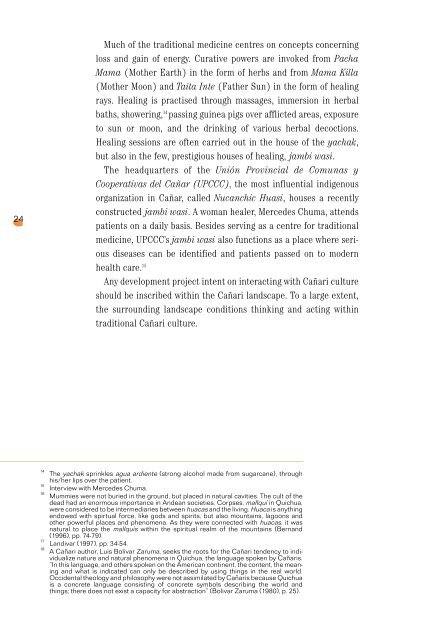mishqui-yacu, sweet water - IFAD
mishqui-yacu, sweet water - IFAD
mishqui-yacu, sweet water - IFAD
Create successful ePaper yourself
Turn your PDF publications into a flip-book with our unique Google optimized e-Paper software.
24<br />
Much of the traditional medicine centres on concepts concerning<br />
loss and gain of energy. Curative powers are invoked from Pacha<br />
Mama (Mother Earth) in the form of herbs and from Mama Killa<br />
(Mother Moon) and Taita Inte (Father Sun) in the form of healing<br />
rays. Healing is practised through massages, immersion in herbal<br />
baths, showering, 14 passing guinea pigs over afflicted areas, exposure<br />
to sun or moon, and the drinking of various herbal decoctions.<br />
Healing sessions are often carried out in the house of the yachak,<br />
but also in the few, prestigious houses of healing, jambi wasi.<br />
The headquarters of the Unión Provincial de Comunas y<br />
Cooperativas del Cañar (UPCCC), the most influential indigenous<br />
organization in Cañar, called Nucanchic Huasi, houses a recently<br />
constructed jambi wasi. A woman healer, Mercedes Chuma, attends<br />
patients on a daily basis. Besides serving as a centre for traditional<br />
medicine, UPCCC’s jambi wasi also functions as a place where serious<br />
diseases can be identified and patients passed on to modern<br />
health care. 15<br />
Any development project intent on interacting with Cañari culture<br />
should be inscribed within the Cañari landscape. To a large extent,<br />
the surrounding landscape conditions thinking and acting within<br />
traditional Cañari culture.<br />
14<br />
15<br />
16<br />
17<br />
18<br />
The yachak sprinkles agua ardiente (strong alcohol made from sugarcane), through<br />
his/her lips over the patient.<br />
Interview with Mercedes Chuma.<br />
Mummies were not buried in the ground, but placed in natural cavities. The cult of the<br />
dead had an enormous importance in Andean societies. Corpses, mallquí in Quichua,<br />
were considered to be intermediaries between huacas and the living. Huaca is anything<br />
endowed with spirtual force, like gods and spirits, but also mountains, lagoons and<br />
other powerful places and phenomena. As they were connected with huacas, it was<br />
natural to place the mallquís within the spiritual realm of the mountains (Bernand<br />
(1996), pp. 74-79).<br />
Landivar (1997), pp. 34-54.<br />
A Cañari author, Luis Bolivar Zaruma, seeks the roots for the Cañari tendency to individualize<br />
nature and natural phenomena in Quichua, the language spoken by Cañaris.<br />
“In this language, and others spoken on the American continent, the content, the meaning<br />
and what is indicated can only be described by using things in the real world.<br />
Occidental theology and philosophy were not assimilated by Cañaris because Quichua<br />
is a concrete language consisting of concrete symbols describing the world and<br />
things; there does not exist a capacity for abstraction” (Bolivar Zaruma (1980), p. 25).
















